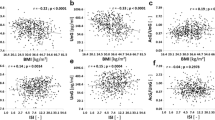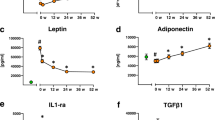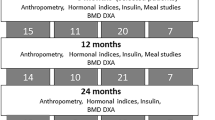Abstract
OBJECTIVE: Recent studies have demonstrated the restoration of a normal 24 h GH profile induced by a reduction of insulinaemia after weight loss, suggesting a reciprocal relationship between plasma insulin and GH concentrations. We aimed to clarify if an opiate-induced reduction in plasma insulin could affect GH secretion in obesity. DESIGN: We have studied the insulin response to an oral glucose tolerance test (OGTT) and the GH response to GHRH before and after prolonged treatment with Naltrexone (NTX). C-peptide, IGF-I, IGFBP-3 plasma levels and the IGF-I/IGFBP-3 molar ratio were also determined. SUBJECTS: Twelve obese women (aged 25–41 y; Body mass index (BMI): 31–39 kg/m2) and six lean normal women (aged 25–38; BMI: 19.8–23.1 kg/m2). MEASUREMENT: GH was determined by the IRMA method; insulin, C-peptide, IGF-I and IGFBP-3 were assayed by the RIA method. For molar comparison between IGF-I and IGFBP-3 we have considered 30.5 kDa the molar weight of IGFBP-3. Results are expressed as mean±s.e.m. RESULTS: We observed a significant decrease in basal concentration of both insulin (230.1±34.9 vs 133.2±16.9 pmol/L; P<0.005) and C-peptide (3.7±0.3 vs 2.4±0.1 µg/L; P<0.02). No modifications in the insulin secretory response to the OGTT were observed. A significant increase of the GHRH-induced GH peak response (7.7±1.4 vs 19.7±3.1 µg/L; P<0.01) and GH-AUC (533±151 vs 1415±339 µg/L/120 min; P<0.01) was found after NTX treatment. A negative correlation was found between basal insulin and GH peak values, both before (r=−0.641, P=0.027) and after NTX (r=−0.714, P=0.013). No modifications were found in IGF-I, IGFBP-3 and IGF-I/IGFBP-3 molar ratio. Moreover, NTX affected neither the insulin response to OGTT or IGF-I, IGFBP-3 and IGF-I/IGFBP-3 molar ratio in a group of six lean controls. Conversely, NTX significantly reduced the GH response to GHRH, when expressed as both peak and AUC values. CONCLUSIONS: The opiate antagonist significantly reduced basal insulin concentrations and augmented the GH response to GHRH in obese subjects. In the absence of modifications in IGF-I and IGFBP-3 plasma levels and their molar ratio, we propose that insulin may exert a negative feedback on GH secretion.
This is a preview of subscription content, access via your institution
Access options
Subscribe to this journal
Receive 12 print issues and online access
$259.00 per year
only $21.58 per issue
Buy this article
- Purchase on Springer Link
- Instant access to full article PDF
Prices may be subject to local taxes which are calculated during checkout
Similar content being viewed by others
Author information
Authors and Affiliations
Rights and permissions
About this article
Cite this article
De Marinis, L., Mancini, A., Valle, D. et al. Influence of chronic Naltrexone treatment on growth hormone and insulin secretion in obese subjects. Int J Obes 21, 1076–1081 (1997). https://doi.org/10.1038/sj.ijo.0800519
Received:
Revised:
Accepted:
Issue Date:
DOI: https://doi.org/10.1038/sj.ijo.0800519
Keywords
This article is cited by
-
Intergenerational effects of preconception opioids on glucose homeostasis and hepatic transcription in adult male rats
Scientific Reports (2022)
-
Effects of ghrelin administration on endocrine and metabolic parameters in obese women with polycystic ovary syndrome
Journal of Endocrinological Investigation (2007)



